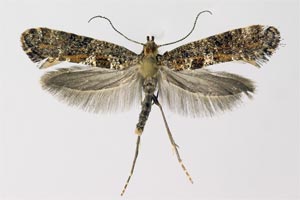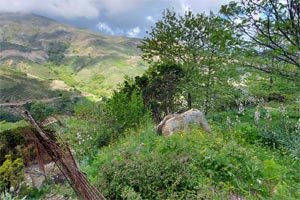4. Weitere Informationen
4.1. Etymologie (Namenserklärung)
Varenne & Nel (2014: 34): « Derivatio-nominis
Espèce dédiée à Pascale Pioz qui participe à toutes les recherches sur le terrain et a capturé l'holotype de la nouvelle espèce. »
4.2. Taxonomie
Huemer & van Nieukerken (2021: 312) bemerken: "Digitivalva piozae was described from a male holotype and a female paratype and separated from other species of the genus, namely D. occidentella (Klimesch, 1956) and D. solidaginis (Staudinger, 1859), by genitalia structures (Varenne & Nel 2014a). However, the nearest neighbour to the successfully sequenced holotype is D. reticulella (Hübner, 1796) with 6.1% divergence."
4.3. Faunistik
Die Art wurde aus Frankreich, Korsika, beschrieben. Bassi & Nel (2015) berichten über den Fund eines ♂ in Italien, Sardinien. Und Huemer & van Nieukerken (2021: 312) berichten über ein per Barcode bestimmtes Tier von Kreta (Griechenland): "Surprisingly the species is more widely distributed than indicated in the original description, with a sequenced record from Greece (Crete)."
(Autor: Erwin Rennwald)
4.4. Typenmaterial
Varenne & Nel (2014: 33): « HOLOTYPE mâle : Haute-Corse, Santa-Lucia-di-Mercurio, 6 juillet 2013, uv, 770 m, Th. Varenne leg., prép. gen. JN n° 26935, coll. Th. Varenne à Nice.
ALLOTYPE femelle : Corse, Rospigliani, 900 m, 21 juillet 2001, S. Peslier leg., prép. gen. JN n° 15692, coll. J. Nel à La Ciotat. »
4.5. Literatur
- Bassi, G. & J. Nel (2015): Due microlepidotteri nuovi per la fauna d’Italia (Lepidoptera: Glyphipterigidae, Acrolepiinae; Tineidae, Hieroxestinae). — Bollettino della Società Entomologica Italiana 147 (3): 135-136 [PDF auf sei.pagepress.org].
- Huemer, P. & E. van Nieukerken (2021): Identity of some recently described Lepidoptera from France — re-assessed with DNA barcodes and morphology. — Zootaxa 4941 (3): 301–337. [zum open-access-Artikel und PDF-download auf mapress.com]
- Erstbeschreibung: Varenne, T. & J. Nel (2014): Quatre nouveaux microlépidoptères pour la France dont Coleophora cyrneogenistae sp. n., Digitivalva piozae sp. n., et Cydia mogeae sp. n. (Lepidoptera, Tineidae, Coleophoridae, Acrolepiidae, Tortricidae). — Revue de l'Association Roussillonnaise d'Entomologie 23 (1): 30-37.




![Vorkommen auf Korsika [Vandromme et al. (2020): Liste systématique et taxinomique des Lépidoptères de France]](/res/img/flag/fr-cor.png)





